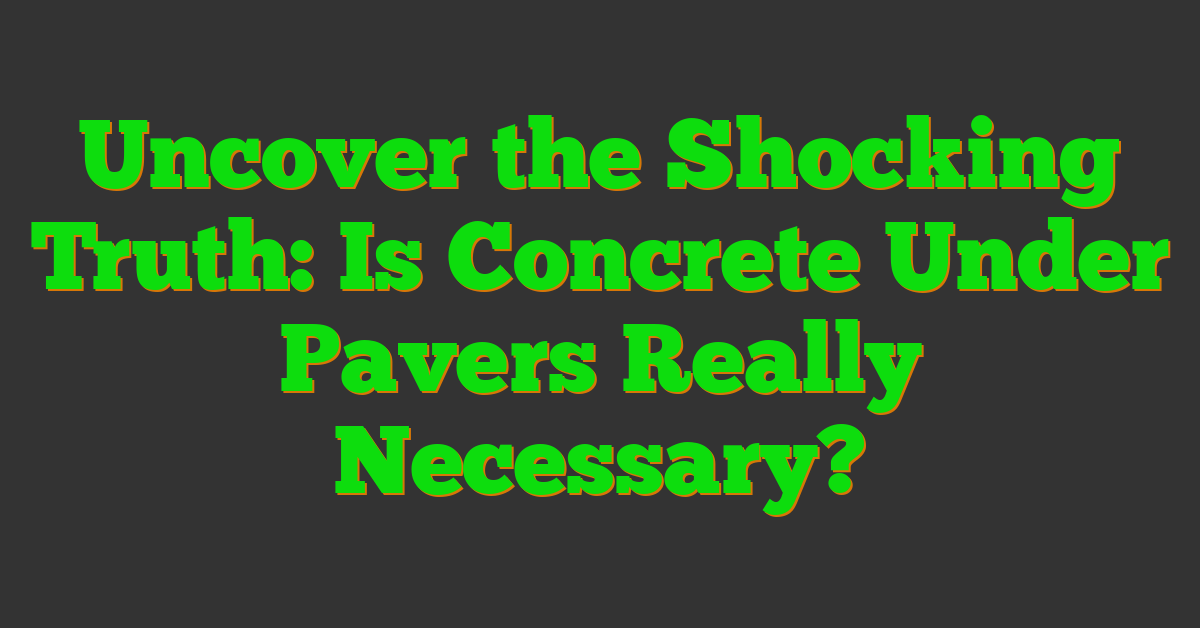So, you’re thinking about installing pavers, but the question on your mind is: do you need to concrete under them? Well, we’ve got you covered! When it comes to laying pavers, the decision of whether or not to use a concrete base is a common dilemma many homeowners face.

In this article, we’ll explore the reasons why adding a concrete base under your pavers might be beneficial, as well as when it could be optional. By understanding the role of concrete in paver installations, you’ll be equipped with the knowledge to make the best choice for your project.
Assessing the Need for Concrete Under Pavers
Considering Soil Types and Climate
When determining whether concrete is necessary under pavers in a landscaping project, we take into account the soil types and the climate of the area. In regions with expansive or poorly draining soils, such as clay soils that are prone to shifting or heaving during freeze-thaw cycles, using a concrete base can provide stability for the pavers. Similarly, in areas with high moisture content or frequent rainfall, a concrete base can prevent settling and ensure the longevity of the paved surface. Therefore, understanding the soil composition and climate is crucial in assessing the need for concrete under pavers.
Evaluating Site Drainage Requirements
Assessing site drainage requirements is essential in determining whether to install a concrete base under pavers. Proper drainage helps prevent water accumulation, which can cause erosion, shifting, or sinking of the pavers over time. In locations where water tends to pool or flow towards the paved area, a concrete base with adequate slope towards drainage features like a perimeter drain or a French drain can help redirect water away from the pavers. By evaluating the site’s drainage needs, we can decide if a concrete base is necessary to maintain the integrity of the paver installation.
Understanding Traffic Levels for Paved Areas
Traffic levels play a significant role in deciding whether to incorporate a concrete base under pavers. Areas with high foot traffic, such as walkways, patios, or driveways, require a stable foundation to withstand the daily wear and tear. Installing pavers directly on compacted soil may not provide sufficient support for heavy traffic loads, leading to uneven surfaces or paver movement. By using a concrete base, we ensure a durable and long-lasting foundation that can withstand the traffic stresses, preserving the aesthetics and functionality of the paved area. Therefore, understanding the expected traffic levels helps us determine the necessity of concrete under pavers in different landscaping projects.
Alternatives to Concrete Bases for Pavers
Using Compacted Gravel or Sand
When considering alternatives to a concrete base for pavers, one effective option is utilizing compacted gravel or sand. This approach offers excellent drainage properties, making it a practical choice for areas where water accumulation is a concern. By compacting the gravel or sand base properly, we can create a stable foundation that supports the pavers while allowing water to flow through easily.
In regions with favorable soil conditions, such as well-draining sandy soils, using compacted gravel or sand can be a sustainable and eco-friendly solution. It’s essential to assess the soil composition and drainage requirements of the project site to determine if this alternative is suitable. Additionally, incorporating geotextile fabric between the soil and the base material can help prevent the migration of fines, ensuring long-term stability for the paved surface.
Exploring Permeable Pavers and Their Benefits
Permeable pavers present another innovative alternative to traditional concrete bases, offering unique advantages in landscaping projects. These environmentally friendly pavers allow water to infiltrate through the surface, reducing stormwater runoff and minimizing erosion. With permeable pavers, we can create aesthetically pleasing hardscapes that also contribute to sustainable water management practices.
In urban areas or locations prone to heavy rainfall, permeable pavers are particularly valuable for mitigating water runoff and enhancing groundwater recharge. By selecting permeable pavers designed with apertures or void spaces, we can promote efficient water infiltration, supporting healthy vegetation and reducing the burden on stormwater systems. Utilizing these pavers aligns with our commitment to environmentally conscious design solutions.
Synthetic Base Panels as Modern Solutions
For clients seeking cutting-edge solutions in paving projects, synthetic base panels offer a modern alternative to traditional concrete bases. These advanced panels are designed to provide a stable and uniform foundation for pavers while enhancing installation efficiency. With interlocking features and precise sizing, synthetic base panels facilitate accurate alignment and positioning of the pavers, resulting in a professional finish.
In areas where soil instability or subsurface conditions pose challenges, synthetic base panels can offer a reliable solution for ensuring the longevity and performance of the paved surface. By leveraging the benefits of these contemporary materials, we can streamline the construction process and deliver durable outcomes that meet the expectations of our clients. Incorporating synthetic base panels demonstrates our adaptability to emerging trends in landscape design.
Installation Pros and Cons
Concrete Base Longevity and Resilience
When considering the installation of pavers, we must weigh the longevity and resilience offered by a concrete base. Concrete provides a solid foundation that can withstand heavy loads and high traffic areas. It ensures long-term stability, preventing the pavers from shifting or settling over time. This durability makes concrete a reliable choice for areas where durability is a top priority, such as driveways and commercial spaces.
While concrete offers exceptional strength, it can be labor-intensive to install, requiring skilled professionals to ensure proper compaction and leveling. Additionally, concrete bases may be prone to cracking over time, especially in regions with freeze-thaw cycles. Regular maintenance and repairs may be necessary to keep the surface smooth and even.
The Flexibility of Non-Concrete Methods
Exploring non-concrete methods for paver installation provides us with flexibility in design and implementation. Using compacted gravel or sand as a base allows for better water drainage, reducing the risk of water pooling and promoting healthy soil conditions. These materials are more forgiving when it comes to minor adjustments during installation, making them ideal for DIY projects or areas with less demanding traffic requirements.
Non-concrete methods also offer quicker installation times compared to concrete, as they do not require curing periods. This can be advantageous for projects that need to be completed within a shorter timeframe. However, it’s essential to consider the load-bearing capacity of these alternative bases to ensure they can support the intended use without shifting or sinking over time.
Cost Comparison
When evaluating the installation pros and cons of concrete versus non-concrete methods, cost plays a significant role. Concrete bases are typically more expensive due to material costs, labor, and equipment requirements. However, the initial investment in a concrete base may pay off in the long run through its durability and minimal maintenance needs.
On the other hand, non-concrete methods like gravel or sand bases are generally more budget-friendly, making them an attractive option for projects with cost constraints. While these alternatives may require more frequent maintenance and repair compared to concrete, the lower upfront costs can make them a practical choice for residential projects or temporary installations.
Whether to opt for a concrete base or explore non-concrete methods depends on various factors such as budget, project timeline, expected traffic levels, and long-term maintenance considerations. By carefully weighing the installation pros and cons of each method, we can make informed decisions to ensure successful paver projects that meet our clients’ needs and preferences.
Maintenance and Repair Considerations
Ease of Access for Underground Utilities
When considering maintenance and repair for pavers installed over a concrete base, we emphasize the importance of evaluating the ease of access to underground utilities. In situations where utility lines run beneath the paved surface, having a concrete base can pose challenges during repairs. The concrete may need to be cut or removed, increasing the complexity and cost of accessing the utilities. On the contrary, using sand or gravel bases allows for easier access to underground utilities, as these materials can be removed and replaced more efficiently without the need for extensive concrete removal, simplifying maintenance tasks and reducing associated costs.
« Shocking Reasons Why Your Pavers Are Sinking! Learn the Surprising Truth Now Why Your Pavers Keep Sinking & How to Stop It: Expert Tips Revealed »
Repairing Pavers Over Concrete vs. Sand/Gravel
In terms of repairing pavers, we acknowledge the differences between concrete and sand/gravel bases. When pavers are laid on a concrete base, repairing damaged or sunken pavers can be more labor-intensive and challenging. The process often involves breaking into the concrete, replacing the affected pavers, and then re-pouring concrete, which can be time-consuming and costly. Conversely, pavers placed over sand or gravel bases offer a simpler repair process. In this scenario, individual pavers can be easily lifted and replaced without the need to deal with concrete, making repairs quicker, more cost-effective, and less disruptive to the overall paved area. This ease of repair is particularly beneficial in areas where maintenance is frequent or where future changes and adjustments are anticipated.
Environmental Impact of Paving Choices
As landscape designers, we always consider the environmental impact of our choices. When it comes to paving, assessing the concrete carbon footprint is a crucial aspect of our decision-making process.
Assessing the Concrete Carbon Footprint
Concrete production has a significant environmental impact due to the high carbon footprint associated with cement manufacturing. Cement production is a major source of greenhouse gas emissions, contributing to global warming. By opting for a concrete base under pavers, we should be mindful of its environmental consequences and explore alternatives to minimize our ecological footprint.
Sustainability of Non-Concrete Options
Non-concrete options such as compacted gravel, sand, permeable pavers, and synthetic base panels offer sustainable alternatives with lower environmental impacts. These materials require less energy for production compared to concrete, reducing overall carbon emissions. Choosing these sustainable options not only benefits the environment but also enhances the eco-friendly aspects of the landscape design.
By considering the sustainability of non-concrete options and evaluating the concrete carbon footprint, we can make informed decisions that align with our commitment to eco-conscious landscaping practices.
Conclusion
Considering soil types, climate conditions, and environmental impact is crucial in determining whether a concrete base is necessary under pavers. Factors such as soil composition, drainage needs, and expected traffic levels play a significant role in this decision. Exploring alternatives like compacted gravel, sand, permeable pavers, and synthetic base panels offers eco-friendly and stable options for landscaping projects. By weighing the sustainability of non-concrete choices against the carbon footprint of concrete, we can make informed decisions that align with environmentally conscious landscaping practices. It’s essential to prioritize good drainage, stability, and environmental sustainability when planning paving projects to minimize ecological footprints and contribute to a greener future.












